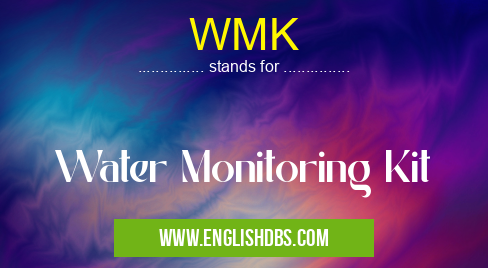What does WMK mean in UNCLASSIFIED
WMK stands for Water Monitoring Kit. It is a comprehensive set of tools and reagents used for monitoring the quality of water. WMKs are widely employed in various fields, including environmental science, water treatment, agriculture, and industrial settings.

WMK meaning in Unclassified in Miscellaneous
WMK mostly used in an acronym Unclassified in Category Miscellaneous that means Water Monitoring Kit
Shorthand: WMK,
Full Form: Water Monitoring Kit
For more information of "Water Monitoring Kit", see the section below.
Components of a WMK
- pH meter for measuring acidity or alkalinity
- Conductivity meter for determining the concentration of dissolved ions
- Dissolved oxygen probe for assessing the amount of oxygen dissolved in water
- Turbidity meter for measuring the cloudiness or suspended solids in water
- Test strips for detecting specific ions or compounds, such as chlorine, nitrate, or phosphate
Applications of WMKs
- Environmental monitoring: Assessing the water quality of rivers, lakes, and groundwater for pollution or contamination
- Water treatment: Monitoring the effectiveness of water purification and filtration systems
- Agriculture: Managing irrigation water quality and nutrient levels in soil
- Industrial settings: Monitoring wastewater treatment processes and preventing contamination
Essential Questions and Answers on Water Monitoring Kit in "MISCELLANEOUS»UNFILED"
What is the purpose of a Water Monitoring Kit (WMK)?
A WMK is a portable device used to test the quality of water sources, primarily for factors like pH, turbidity, dissolved oxygen, and other chemical or biological parameters. It helps monitor water purity, detect contaminants, and assess water suitability for various purposes.
What parameters can a WMK typically measure?
Common parameters measured by WMKs include pH, turbidity, dissolved oxygen, conductivity, temperature, and salinity. Some kits may also test for specific contaminants like nitrates, phosphates, or heavy metals.
How accurate are WMK readings?
The accuracy of WMK readings depends on the quality and calibration of the device. Generally, WMKs provide reliable readings within acceptable ranges for most parameters. However, it's important to follow the manufacturer's instructions carefully and calibrate the kit regularly for optimal results.
How do I use a WMK?
Using a WMK involves collecting a water sample, adding reagents (if necessary), and observing the resulting color changes or readings on a display. Different parameters require specific procedures, so it's essential to refer to the manufacturer's instructions for detailed guidance.
What are the benefits of using a WMK?
WMKs offer several benefits, including:
- Water Quality Assessment: Monitor water quality for various purposes, such as drinking, irrigation, or aquatic life.
- Contaminant Detection: Identify potential contaminants and their levels in water sources.
- Environmental Monitoring: Track water quality changes over time to assess environmental impact and pollution.
- Health and Safety: Ensure water sources are safe for drinking, recreation, or other uses.
Final Words: WMKs are essential tools for monitoring the quality of water and ensuring its safety for various uses. By providing accurate and reliable measurements, WMKs aid in protecting public health, preserving ecosystems, and optimizing water management practices.
